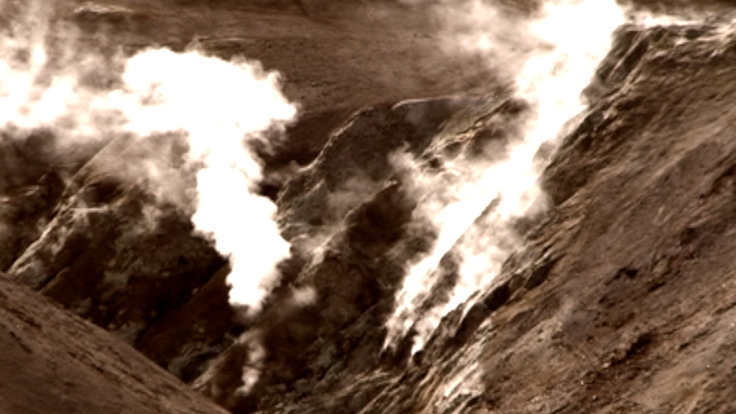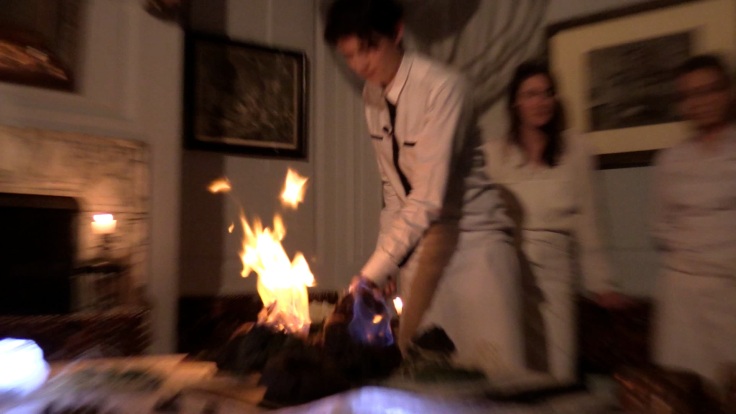by Annabel Huxley


Our aim was to use “food to evoke and provoke essential states of the mind which otherwise cannot be evoked and provoked” Marinetti, The Futurist Cookbook.
What would Iceland taste, smell and feel like if you could whet your senses on a journey through that landscape? Ice, rock, sea, salt, coal, fish, crystals, lamb, heat, cold, smoke, foam, dark, light – intense, elemental and surprising. On just such a journey, Czech film maker Tereza Stehlikova, like William Morris before her, was captivated by the earthiness and scale of the land, encrusted with powerful sensory experiences for the observant traveller.
Could one make a dinner that tasted like Iceland? Why would you?
Well, if you were an artist interested in translating experience into film, a cook interested in neuroscience and a scientist researching cross-modal sensory experiences you might together conceive of and design a dining experience that also served as an experiment, one that tickled the senses, surprised the mind and provided some sort of evaluative data (however lab-free and ‘wild’). And a setting reflecting Morris’ journey through Iceland would introduce a rich layer of cross-reference, juxtaposing the geographical journey with the sensory, the external with the internal.
“Iceland is a land stripped to the bare essentials. An encounter with Iceland was an elemental experience. And in a way the Icelandic Dining Exploration needed to begin with elements”, explained Stehlikova.


And so a dinner, positioned somewhere between a banquet, theatre performance and live experiment was manifest. Inspired by Morris’s 1871 Travel Diaries around the coast of Iceland in a 3 month journey that summer, it was conceived and initiated by artist and filmmaker, Tereza Stehlikova as part of her research based at the Royal College of Art. The look, feel and smell of the dinner, together with its combination of food flavours, was developed by cook and ‘neurogastronomist’ Charles Michel. The sensory overview and experimental framework was provided by psychologist Professor Charles Spence, with whom Charles Michel works in Spence’s Crossmodal Research laboratory in Oxford. Also brought in by Stehlikova was an astonishing array of other creatives – sound artists, perfumers, set designers, lighting designers, florists, food historians and performers to perform and advise on aesthetics and cross-disciplinary data collection.
The concept of an Icelandic Dining Experience reflects a whole new area of research into the sensory and experiential process of eating, drinking and dining. Reflecting Heston Blumenthal’s success with his innovative approach to food-as-experiment, this is fertile ground for science and chefs, designers, artists and consumers. From the tablecloth to the menu, weight, sound, temperature and texture can have a dramatic effect on our perceptions of food and drink.


Together Stehlikova, Spence and Michel set out to ask such questions as: “What is the effect of texture on the experience of flavour? How might sound affect our perception of taste? How might we create an environment that provides a complex set of multi-sensory stimuli and how might we test the experience on ratings of food?”
So, on a suitably cold November 2013, I was one of 24 lucky participants invited to an “Icelandic Dining Exploration” at Black’s Club in Soho. We were instructed to arrive wearing gloves and not to take them off until asked in order to heighten our sense of touch. A few of us met up on the street, figuring these odd creatures, caped and cold, were probably on the same guest list. We were led downstairs where, blindfolded, we were sat around Georgian trestle tables in the basement of Black’s Club in Soho. Like children at a parlour game, we passed objects around the table, touching, smelling, listening. To the sound of the sea washing over a laval shore, our senses were sharpened as we felt our way into an Icelandic landscape of rock, bark, wet moss, feather, winds and smoke.



The dining experience unfolded in a series of courses delivered in different rooms throughout the Club over a period of two and a half hours. Guests wandered and ate, drank and talked in no particular order as wooden platters and pewter plates were artfully laid on tables or handed around. Each dish was a surprise, an expression of six months of combined research and thoughtfulness by the Exploration Team. Salty John Dory nestled in medicinal sponge mushroom; sooty sourdough and root vegetables recalled a coppice and earth; the intense tastes of white truffle and black squid ink were blended on a brush to reflect Icelandic grey skies; sea bass harvested from cold Arctic seas and warm smoke-stewed lamb was served on foraged shimeji mushrooms; and we finished with a chocolate pudding made with cocoa from volcanic lands, sooty, and sweetened with rowan berry jelly.


The curious feast recalled Alice’s surprise with bottles and cake, and inspired engaging conversations amongst carefully selected guests – the latest thinking on umami and taste with scientists working on sensory perception, an exploration of our emotions and perceptions with artists and curators working in art-science, the nature of storytelling and forms of travel with food writers and poets, filmmakers, historians and academics.
For William Morris, his journey round Iceland was in part an escape from marital difficulties. What he found there – a tough but self-assured people, with strong social values, family bonds and a gift for storytelling – proved a political and personal turning point for Morris. His discovery of Iceland, “most romantic of all deserts”, was to give him a pioneering social and political stimulus that lasted all his life.
For Stehlikova and her team, while relieved of the constraints of the lab, what they conceived was nevertheless the beginning of an experiment. Exploring the boundaries of art and science, it both referenced a centuries-long history of inquiry into food and intoxication and, more recently, the Futurists’ interest in food as a state of mind, while also providing data for new research exploring how we taste as much with our mind and our eyes as with our sensory organs and our taste receptors. All the proceedings leading up to the event were recorded. The event itself was filmed in detail. There is interest from Italy and Germany in extending the experiment, using a control group, where only the food is served without the setting. For her own art work, and with the help of two cameramen, Stehlikova is now working to create a short film based on the event, one that blurs documentary and fiction, subjective experience with facts, reality with dreams.
Some funding came from the AHRC Science in Culture programme, through Prof Barry Smith, from the Centre for the Study of the Senses, or CenSes at UCL.
A short video by Tereza which captures the transformative experience can be seen here.
Annabel Huxley, One Culture Communications, http://www.annabelhuxley.com/
15 January 2014
NOTE: Today’s post marks the 10th anniversary of this project, which took place on 24th November 2013.
